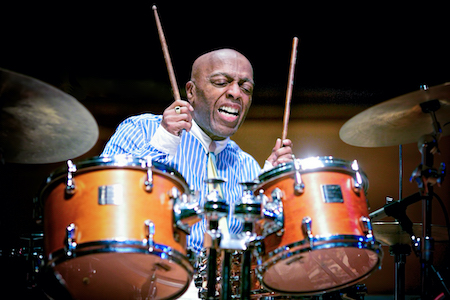
Roy Haynes: The Life and Legacy of a Jazz Drumming Icon
Roy Haynes was born Roy Owen Hayneson born on March 13, 1925, and was an American jazz drummer and one of the most recorded musicians in jazz history.
Over an illustrious career spanning more than 80 years, Haynes shaped the sounds of jazz with his unique drumming style, characterized by innovation, versatility, and a profound understanding of rhythm. Known for his nickname “Snap Crackle,” Haynes pioneered new drumming techniques that pushed the boundaries of swing, bebop, jazz fusion, and avant-garde jazz, earning his place as a legendary figure in jazz music. Through his collaborations with some of the greatest musicians in jazz, Haynes left an indelible mark on the genre, influencing generations of drummers and jazz aficionados around the world.
Early Life and Musical Beginnings
Roy Haynes was born in Roxbury, Massachusetts, a historically significant neighborhood in Boston with a rich cultural heritage. Growing up in this vibrant environment, Haynes was exposed to various forms of music from a young age. He showed an early aptitude for rhythm, a gift that would guide him toward his future in jazz. His early inspirations included the sounds of swing music, big bands, and the innovative drummers of the 1930s and 1940s, like Chick Webb and Jo Jones. These influences, combined with Haynes’ natural talent, laid the foundation for his distinctive style.
In the early 1940s, Haynes began his professional career by playing local gigs around Boston. By the time he turned 20, he had already developed a reputation as a promising young drummer, catching the attention of several prominent musicians. In 1945, Haynes got his first big break when he was invited to join the Luis Russell Orchestra, a highly regarded jazz ensemble that had previously featured Louis Armstrong. This opportunity marked the beginning of Haynes’ journey through the world of jazz, exposing him to the dynamics of a professional jazz band and allowing him to hone his craft.
Breakthrough and the Birth of “Snap Crackle”
The late 1940s were a period of intense creativity and transformation in jazz, as bebop emerged as the new wave in the genre. This style emphasized complex chord progressions, rapid tempos, and a new level of improvisational freedom. Roy Haynes found himself drawn to the energy and innovation of bebop, and his drumming style began to evolve in response. In 1947, Haynes joined the band of saxophonist Lester Young, known for his laid-back, “cool” sound and sophisticated approach to jazz. Playing with Young offered Haynes the chance to develop his own sound, a blend of dynamic rhythm and subtlety that became his trademark.
During this period, Roy Haynes earned the nickname “Snap Crackle,” a moniker that would follow him throughout his career. This nickname was inspired by the distinctive “snap” and “crackle” sounds he could create on his snare drum, which gave his drumming a percussive, almost vocal quality. Haynes’ drumming was characterized by quick, explosive fills and a unique approach to syncopation. He mastered the art of creating rhythmic tension and release, giving his drumming an edge that complemented the unpredictable nature of bebop. His drumming added depth and color to the music, a quality that made him a sought-after collaborator for many leading jazz artists.
Collaboration with Jazz Giants
Throughout the 1950s and 1960s, Roy Haynes collaborated with a veritable “who’s who” of jazz legends. One of his most significant partnerships was with saxophonist Charlie Parker, a pioneer of bebop and one of the most influential musicians in jazz history. Haynes joined Parker’s band in 1949, and the two quickly developed a remarkable musical chemistry. Parker’s fast-paced improvisations required a drummer who could match his intensity and creativity, and Haynes was more than up to the task. Together, they performed and recorded groundbreaking music that helped define the bebop era.
In addition to his work with Parker, Haynes also played with other jazz luminaries such as Thelonious Monk, Miles Davis, and Sarah Vaughan. His collaborations with Monk were particularly notable; Monk’s unconventional compositions and abstract approach to harmony posed unique challenges, but Haynes’ flexibility and inventive style allowed him to complement Monk’s idiosyncratic sound. Haynes’ ability to adapt to the unique needs of each artist with whom he worked was one of his greatest strengths. Whether it was the soulful voice of Sarah Vaughan or the modal experimentation of Miles Davis, Haynes always found a way to enhance the music without overpowering it.
One of Roy Haynes’ most enduring partnerships was with saxophonist John Coltrane. In the early 1960s, Haynes began performing with Coltrane, a musician who was constantly pushing the boundaries of jazz. Coltrane’s exploration of modal jazz and his later forays into avant-garde jazz required a drummer who could navigate complex time signatures and intense, spiritually charged improvisations. Haynes rose to the challenge, using his drumming to create a powerful, almost hypnotic pulse that became an integral part of Coltrane’s sound. This collaboration resulted in some of the most influential recordings in jazz history, including the album Coltrane Live at the Village Vanguard.
Innovation and the Rise of Jazz Fusion
In the late 1960s and early 1970s, jazz underwent yet another transformation with the rise of jazz fusion, a genre that blended elements of jazz with rock, funk, and electronic music. Always an innovator, Haynes embraced these changes and adapted his drumming to fit the evolving sound of jazz. Unlike some of his contemporaries who viewed fusion with skepticism, Haynes recognized its potential and integrated elements of rock and funk rhythms into his playing. His willingness to experiment with different styles and sounds kept his drumming fresh and relevant, allowing him to remain active in a music scene that was constantly evolving.
.
.
Roy Haynes’ foray into jazz fusion was exemplified by his work with Chick Corea, an innovative pianist and composer who was at the forefront of the fusion movement. Together, they formed the band “Roy Haynes’ Hip Ensemble,” a group that pushed the limits of jazz and explored new sonic territories. Haynes’ drumming in the Hip Ensemble incorporated the backbeat and grooves associated with rock and funk, demonstrating his ability to transcend traditional jazz boundaries. This adaptability and willingness to take risks set Haynes apart from many other drummers of his generation, as he continued to find new ways to express himself through his instrument.
Legacy and Influence
Over the course of his career, Roy Haynes’ contributions to jazz drumming were unparalleled. He developed a style that was uniquely his own, characterized by a crisp, articulate sound and a rhythmic complexity that few could match. Haynes was known for his use of space and silence, allowing each note to resonate and giving his drumming a conversational quality. His approach to rhythm was both precise and spontaneous, a paradox that made his performances captivating. As a result, he became a role model for countless drummers, inspiring them to explore the full expressive potential of the drum kit.
One of Haynes’ most significant contributions to jazz drumming was his emphasis on the ride cymbal as a primary rhythmic tool. While earlier drummers had primarily used the bass drum to keep time, Haynes shifted the focus to the ride cymbal, creating a lighter, more nuanced sound that was better suited to the fast tempos of bebop. This innovation influenced an entire generation of drummers, who adopted Haynes’ approach and incorporated it into their own playing.
Roy Haynes’ influence extended far beyond jazz; his drumming style resonated with musicians in rock, pop, and other genres as well. Artists such as Jimi Hendrix and the Rolling Stones expressed admiration for his work, and Haynes’ impact can be seen in the rhythmic experimentation of modern drummers across a wide range of musical styles. His ability to blend tradition with innovation ensured that his legacy would endure, bridging the gap between the classic jazz of the 1940s and the genre’s modern incarnations.
Personal Life and Later Years
Despite his fame and success, Roy Haynes remained a humble and grounded individual, known for his warm personality and positive attitude. He often spoke of his deep love for music and his gratitude for the opportunities he had been given. In interviews, Haynes frequently expressed his belief that music was a universal language that could bring people together, a philosophy that was reflected in his open-minded approach to collaboration.
.

.
In the later years of his career, Roy Haynes continued to perform and record music, even as he approached his 90s. He remained a popular figure at jazz festivals around the world, captivating audiences with his boundless energy and skill. Haynes’ dedication to his craft was evident in every performance, as he maintained the same level of enthusiasm and passion that had defined his early career. His resilience and longevity made him a beloved figure in the jazz community, admired not only for his musical contributions but also for his unwavering commitment to the art form.
Conclusion: A Lasting Legacy
Roy Haynes’ passing on November 12, 2024, marked the end of an era in jazz, but his influence will live on for generations to come. As one of the most recorded drummers in jazz, Haynes left behind a vast body of work that serves as a testament to his talent, creativity, and vision. His ability to adapt to different styles and push the boundaries of jazz drumming made him a true innovator, a pioneer who helped shape the sound of modern jazz. “Snap Crackle” may have been a nickname, but it also captured the essence of Haynes’ style – a blend of precision, spontaneity, and a rhythmic “crackle” that brought his drumming to life.
Roy Haynes’ legacy will continue to inspire musicians, particularly drummers, to explore the limitless possibilities of rhythm and to approach music with the same sense of curiosity and passion that defined his life. In the annals of jazz history, Haynes stands as a towering figure, a master of his craft who left an indelible mark on the world of music.
Check out Roy Haynes on Amazon.
.

